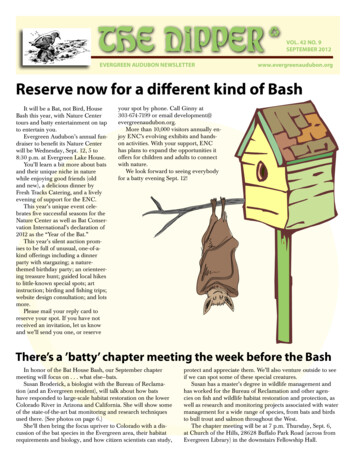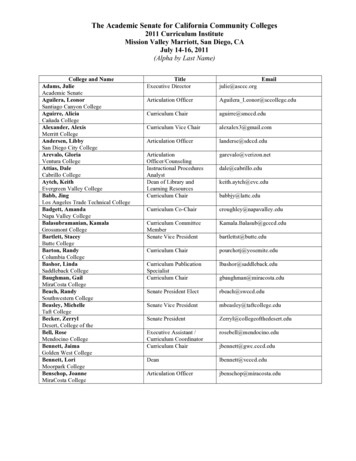
Transcription
Ur-FascismUmberto EcoNEW YORK REVIEW OF BOOKS -- JUNE 22, 1995 ISSUEIn 1942, at the age of ten, I received the First Provincial Award of Ludi Juveniles (a voluntary,compulsory competition for young Italian Fascists—that is, for every young Italian). I elaboratedwith rhetorical skill on the subject “Should we die for the glory of Mussolini and the immortaldestiny of Italy?” My answer was positive. I was a smart boy.I spent two of my early years among the SS, Fascists, Republicans, and partisans shooting at oneanother, and I learned how to dodge bullets. It was good exercise.In April 1945, the partisans took over in Milan. Two days later they arrived in the small townwhere I was living at the time. It was a moment of joy. The main square was crowded withpeople singing and waving flags, calling in loud voices for Mimo, the partisan leader of that area.A former maresciallo of the Carabinieri, Mimo joined the supporters of General Badoglio,Mussolini’s successor, and lost a leg during one of the first clashes with Mussolini’s remainingforces. Mimo showed up on the balcony of the city hall, pale, leaning on his crutch, and with onehand tried to calm the crowd. I was waiting for his speech because my whole childhood had beenmarked by the great historic speeches of Mussolini, whose most significant passages wememorized in school. Silence. Mimo spoke in a hoarse voice, barely audible. He said: “Citizens,friends. After so many painful sacrifices here we are. Glory to those who have fallen forfreedom.” And that was it. He went back inside. The crowd yelled, the partisans raised their gunsand fired festive volleys. We kids hurried to pick up the shells, precious items, but I had alsolearned that freedom of speech means freedom from rhetoric.A few days later I saw the first American soldiers. They were African Americans. The firstYankee I met was a black man, Joseph, who introduced me to the marvels of Dick Tracy and Li’lAbner. His comic books were brightly colored and smelled good.One of the officers (Major or Captain Muddy) was a guest in the villa of a family whose twodaughters were my schoolmates. I met him in their garden where some ladies, surroundingCaptain Muddy, talked in tentative French. Captain Muddy knew some French, too. My firstimage of American liberators was thus—after so many palefaces in black shirts—that of acultivated black man in a yellow-green uniform saying: “Oui, merci beaucoup, Madame, moiaussi j’aime le champagne ” Unfortunately there was no champagne, but Captain Muddy gaveme my first piece of Wrigley’s Spearmint and I started chewing all day long. At night I put mywad in a water glass, so it would be fresh for the next day.In May we heard that the war was over. Peace gave me a curious sensation. I had been told thatpermanent warfare was the normal condition for a young Italian. In the following months Idiscovered that the Resistance was not only a local phenomenon but a European one. I learnednew, exciting words like réseau, maquis, armée secrète, Rote Kapelle, Warsaw ghetto. I saw thefirst photographs of the Holocaust, thus understanding the meaning before knowing the word. Irealized what we were liberated from.
In my country today there are people who are wondering if the Resistance had a real militaryimpact on the course of the war. For my generation this question is irrelevant: we immediatelyunderstood the moral and psychological meaning of the Resistance. For us it was a point of prideto know that we Europeans did not wait passively for liberation. And for the young Americanswho were paying with their blood for our restored freedom it meant something to know thatbehind the firing lines there were Europeans paying their own debt in advance.In my country today there are those who are saying that the myth of the Resistance was aCommunist lie. It is true that the Communists exploited the Resistance as if it were their personalproperty, since they played a prime role in it; but I remember partisans with kerchiefs of differentcolors. Sticking close to the radio, I spent my nights—the windows closed, the blackout makingthe small space around the set a lone luminous halo—listening to the messages sent by the Voiceof London to the partisans. They were cryptic and poetic at the same time (The sun also rises,The roses will bloom) and most of them were “messaggi per la Franchi.” Somebody whisperedto me that Franchi was the leader of the most powerful clandestine network in northwestern Italy,a man of legendary courage. Franchi became my hero. Franchi (whose real name was EdgardoSogno) was a monarchist, so strongly anti-Communist that after the war he joined very rightwing groups, and was charged with collaborating in a project for a reactionary coup d’état. Whocares? Sogno still remains the dream hero of my childhood. Liberation was a common deed forpeople of different colors.In my country today there are some who say that the War of Liberation was a tragic period ofdivision, and that all we need is national reconciliation. The memory of those terrible yearsshould be repressed, refoulée, verdrängt. But Verdrängung causes neurosis. If reconciliationmeans compassion and respect for all those who fought their own war in good faith, to forgivedoes not mean to forget. I can even admit that Eichmann sincerely believed in his mission, but Icannot say, “OK, come back and do it again.” We are here to remember what happened andsolemnly say that “They” must not do it again.But who are They?If we still think of the totalitarian governments that ruled Europe before the Second World Warwe can easily say that it would be difficult for them to reappear in the same form in differenthistorical circumstances. If Mussolini’s fascism was based upon the idea of a charismatic ruler,on corporatism, on the utopia of the Imperial Fate of Rome, on an imperialistic will to conquernew territories, on an exacerbated nationalism, on the ideal of an entire nation regimented inblack shirts, on the rejection of parliamentary democracy, on anti-Semitism, then I have nodifficulty in acknowledging that today the Italian Alleanza Nazionale, born from the postwarFascist Party, MSI, and certainly a right-wing party, has by now very little to do with the oldfascism. In the same vein, even though I am much concerned about the various Nazi-likemovements that have arisen here and there in Europe, including Russia, I do not think thatNazism, in its original form, is about to reappear as a nationwide movement.Nevertheless, even though political regimes can be overthrown, and ideologies can be criticizedand disowned, behind a regime and its ideology there is always a way of thinking and feeling, agroup of cultural habits, of obscure instincts and unfathomable drives. Is there still another ghoststalking Europe (not to speak of other parts of the world)?
Ionesco once said that “only words count and the rest is mere chattering.” Linguistic habits arefrequently important symptoms of underlying feelings. Thus it is worth asking why not only theResistance but the Second World War was generally defined throughout the world as a struggleagainst fascism. If you reread Hemingway’s For Whom the Bell Tolls you will discover thatRobert Jordan identifies his enemies with Fascists, even when he thinks of the SpanishFalangists. And for FDR, “The victory of the American people and their allies will be a victoryagainst fascism and the dead hand of despotism it represents.”During World War II, the Americans who took part in the Spanish war were called “prematureanti-fascists”—meaning that fighting against Hitler in the Forties was a moral duty for everygood American, but fighting against Franco too early, in the Thirties, smelled sour because it wasmainly done by Communists and other leftists. Why was an expression like fascist pig usedby American radicals thirty years later to refer to a cop who did not approve of their smokinghabits? Why didn’t they say: Cagoulard pig, Falangist pig, Ustashe pig, Quisling pig, Nazi pig?Mein Kampf is a manifesto of a complete political program. Nazism had a theory of racism andof the Aryan chosen people, a precise notion of degenerate art, entartete Kunst, a philosophy ofthe will to power and of the Ubermensch. Nazism was decidedly anti-Christian and neo-pagan,while Stalin’s Diamat (the official version of Soviet Marxism) was blatantly materialistic andatheistic. If by totalitarianism one means a regime that subordinates every act of the individual tothe state and to its ideology, then both Nazism and Stalinism were true totalitarian regimes.Italian fascism was certainly a dictatorship, but it was not totally totalitarian, not because of itsmildness but rather because of the philosophical weakness of its ideology. Contrary to commonopinion, fascism in Italy had no special philosophy. The article on fascism signed by Mussoliniin the Treccani Encyclopedia was written or basically inspired by Giovanni Gentile, but itreflected a late-Hegelian notion of the Absolute and Ethical State which was never fully realizedby Mussolini. Mussolini did not have any philosophy: he had only rhetoric. He was a militantatheist at the beginning and later signed the Convention with the Church and welcomed thebishops who blessed the Fascist pennants. In his early anticlerical years, according to a likelylegend, he once asked God, in order to prove His existence, to strike him down on the spot.Later, Mussolini always cited the name of God in his speeches, and did not mind being called theMan of Providence.Italian fascism was the first right-wing dictatorship that took over a European country, and allsimilar movements later found a sort of archetype in Mussolini’s regime. Italian fascism was thefirst to establish a military liturgy, a folklore, even a way of dressing—far more influential, withits black shirts, than Armani, Benetton, or Versace would ever be. It was only in the Thirties thatfascist movements appeared, with Mosley, in Great Britain, and in Latvia, Estonia, Lithuania,Poland, Hungary, Romania, Bulgaria, Greece, Yugoslavia, Spain, Portugal, Norway, and even inSouth America. It was Italian fascism that convinced many European liberal leaders that the newregime was carrying out interesting social reform, and that it was providing a mildlyrevolutionary alternative to the Communist threat.Nevertheless, historical priority does not seem to me a sufficient reason to explain why theword fascism became a synecdoche, that is, a word that could be used for different totalitarianmovements. This is not because fascism contained in itself, so to speak in their quintessential
state, all the elements of any later form of totalitarianism. On the contrary, fascism had noquintessence. Fascism was a fuzzy totalitarianism, a collage of different philosophical andpolitical ideas, a beehive of contradictions. Can one conceive of a truly totalitarian movementthat was able to combine monarchy with revolution, the Royal Army with Mussolini’spersonal milizia, the grant of privileges to the Church with state education extolling violence,absolute state control with a free market? The Fascist Party was born boasting that it brought arevolutionary new order; but it was financed by the most conservative among the landownerswho expected from it a counter-revolution. At its beginning fascism was republican. Yet itsurvived for twenty years proclaiming its loyalty to the royal family, while the Duce (theunchallenged Maximal Leader) was arm-in-arm with the King, to whom he also offered the titleof Emperor. But when the King fired Mussolini in 1943, the party reappeared two months later,with German support, under the standard of a “social” republic, recycling its old revolutionaryscript, now enriched with almost Jacobin overtones.There was only a single Nazi architecture and a single Nazi art. If the Nazi architect was AlbertSpeer, there was no more room for Mies van der Rohe. Similarly, under Stalin’s rule, if Lamarckwas right there was no room for Darwin. In Italy there were certainly fascist architects but closeto their pseudo-Coliseums were many new buildings inspired by the modern rationalism ofGropius.There was no fascist Zhdanov setting a strictly cultural line. In Italy there were two important artawards. The Premio Cremona was controlled by a fanatical and uncultivated Fascist, RobertoFarinacci, who encouraged art as propaganda. (I can remember paintings with such titlesas Listening by Radio to the Duce’s Speech or States of Mind Created by Fascism.) The PremioBergamo was sponsored by the cultivated and reasonably tolerant Fascist Giuseppe Bottai, whoprotected both the concept of art for art’s sake and the many kinds of avant-garde art that hadbeen banned as corrupt and crypto-Communist in Germany.The national poet was D’Annunzio, a dandy who in Germany or in Russia would have been sentto the firing squad. He was appointed as the bard of the regime because of his nationalism andhis cult of heroism—which were in fact abundantly mixed up with influences of French fin desiècle decadence.Take Futurism. One might think it would have been considered an instance of entartete Kunst,along with Expressionism, Cubism, and Surrealism. But the early Italian Futurists werenationalist; they favored Italian participation in the First World War for aesthetic reasons; theycelebrated speed, violence, and risk, all of which somehow seemed to connect with the fascistcult of youth. While fascism identified itself with the Roman Empire and rediscovered ruraltraditions, Marinetti (who proclaimed that a car was more beautiful than the Victory ofSamothrace, and wanted to kill even the moonlight) was nevertheless appointed as a member ofthe Italian Academy, which treated moonlight with great respect.Many of the future partisans and of the future intellectuals of the Communist Party wereeducated by the GUF, the fascist university students’ association, which was supposed to be thecradle of the new fascist culture. These clubs became a sort of intellectual melting pot where newideas circulated without any real ideological control. It was not that the men of the party weretolerant of radical thinking, but few of them had the intellectual equipment to control it.
During those twenty years, the poetry of Montale and other writers associated with the groupcalled the Ermetici was a reaction to the bombastic style of the regime, and these poets wereallowed to develop their literary protest from within what was seen as their ivory tower. Themood of the Ermetici poets was exactly the reverse of the fascist cult of optimism and heroism.The regime tolerated their blatant, even though socially imperceptible, dissent because theFascists simply did not pay attention to such arcane language.All this does not mean that Italian fascism was tolerant. Gramsci was put in prison until hisdeath; the opposition leaders Giacomo Matteotti and the brothers Rosselli were assassinated; thefree press was abolished, the labor unions were dismantled, and political dissenters wereconfined on remote islands. Legislative power became a mere fiction and the executive power(which controlled the judiciary as well as the mass media) directly issued new laws, among themlaws calling for preservation of the race (the formal Italian gesture of support for what becamethe Holocaust).The contradictory picture I describe was not the result of tolerance but of political andideological discombobulation. But it was a rigid discombobulation, a structured confusion.Fascism was philosophically out of joint, but emotionally it was firmly fastened to somearchetypal foundations.So we come to my second point. There was only one Nazism. We cannot label Franco’s hyperCatholic Falangism as Nazism, since Nazism is fundamentally pagan, polytheistic, and antiChristian. But the fascist game can be played in many forms, and the name of the game does notchange. The notion of fascism is not unlike Wittgenstein’s notion of a game. A game can beeither competitive or not, it can require some special skill or none, it can or cannot involvemoney. Games are different activities that display only some “family resemblance,” asWittgenstein put it. Consider the following sequence:1234abc bcd cde defSuppose there is a series of political groups in which group one is characterized by thefeatures abc, group two by the features bcd, and so on. Group two is similar to group one sincethey have two features in common; for the same reasons three is similar to two and four issimilar to three. Notice that three is also similar to one (they have in common the feature c). Themost curious case is presented by four, obviously similar to three and two, but with no feature incommon with one. However, owing to the uninterrupted series of decreasing similarities betweenone and four, there remains, by a sort of illusory transitivity, a family resemblance between fourand one.Fascism became an all-purpose term because one can eliminate from a fascist regime one ormore features, and it will still be recognizable as fascist. Take away imperialism from fascismand you still have Franco and Salazar. Take away colonialism and you still have the Balkanfascism of the Ustashes. Add to the Italian fascism a radical anti-capitalism (which never muchfascinated Mussolini) and you have Ezra Pound. Add a cult of Celtic mythology and the Grail
mysticism (completely alien to official fascism) and you have one of the most respected fascistgurus, Julius Evola.But in spite of this fuzziness, I think it is possible to outline a list of features that are typical ofwhat I would like to call Ur-Fascism, or Eternal Fascism. These features cannot be organizedinto a system; many of them contradict each other, and are also typical of other kinds ofdespotism or fanaticism. But it is enough that one of them be present to allow fascism tocoagulate around it.1. The first feature of Ur-Fascism is the cult of tradition. Traditionalism is of course much olderthan fascism. Not only was it typical of counter-revolutionary Catholic thought after the Frenchrevolution, but it was born in the late Hellenistic era, as a reaction to classical Greek rationalism.In the Mediterranean basin, people of different religions (most of them indulgently accepted bythe Roman Pantheon) started dreaming of a revelation received at the dawn of human history.This revelation, according to the traditionalist mystique, had remained for a long time concealedunder the veil of forgotten languages—in Egyptian hieroglyphs, in the Celtic runes, in the scrollsof the little known religions of Asia.This new culture had to be syncretistic. Syncretism is not only, as the dictionary says, “thecombination of different forms of belief or practice”; such a combination must toleratecontradictions. Each of the original messages contains a silver of wisdom, and whenever theyseem to say different or incompatible things it is only because all are alluding, allegorically, tothe same primeval truth.As a consequence, there can be no advancement of learning. Truth has been already spelled outonce and for all, and we can only keep interpreting its obscure message.One has only to look at the syllabus of every fascist movement to find the major traditionalistthinkers. The Nazi gnosis was nourished by traditionalist, syncretistic, occult elements. The mostinfluential theoretical source of the theories of the new Italian right, Julius Evola, merged theHoly Grail with The Protocols of the Elders of Zion, alchemy with the Holy Roman andGermanic Empire. The very fact that the Italian right, in order to show its open-mindedness,recently broadened its syllabus to include works by De Maistre, Guenon, and Gramsci, is ablatant proof of syncretism.If you browse in the shelves that, in American bookstores, are labeled as New Age, you can findthere even Saint Augustine who, as far as I know, was not a fascist. But combining SaintAugustine and Stonehenge—that is a symptom of Ur-Fascism.2. Traditionalism implies the rejection of modernism. Both Fascists and Nazis worshipedtechnology, while traditionalist thinkers usually reject it as a negation of traditional spiritualvalues. However, even though Nazism was proud of its industrial achievements, its praise ofmodernism was only the surface of an ideology based upon Blood and Earth (Blut und Boden).The rejection of the modern world was disguised as a rebuttal of the capitalistic way of life, but itmainly concerned the rejection of the Spirit of 1789 (and of 1776, of course). TheEnlightenment, the Age of Reason, is seen as the beginning of modern depravity. In this senseUr-Fascism can be defined as irrationalism.
3. Irrationalism also depends on the cult of action for action’s sake. Action being beautiful initself, it must be taken before, or without, any previous reflection. Thinking is a form ofemasculation. Therefore culture is suspect insofar as it is identified with critical attitudes.Distrust of the intellectual world has always been a symptom of Ur-Fascism, from Goering’salleged statement (“When I hear talk of culture I reach for my gun”) to the frequent use of suchexpressions as “degenerate intellectuals,” “eggheads,” “effete snobs,” “universities are a nest ofreds.” The official Fascist intellectuals were mainly engaged in attacking modern culture and theliberal intelligentsia for having betrayed traditional values.4. No syncretistic faith can withstand analytical criticism. The critical spirit makes distinctions,and to distinguish is a sign of modernism. In modern culture the scientific community praisesdisagreement as a way to improve knowledge. For Ur-Fascism, disagreement is treason.5. Besides, disagreement is a sign of diversity. Ur-Fascism grows up and seeks for consensus byexploiting and exacerbating the natural fear of difference. The first appeal of a fascist orprematurely fascist movement is an appeal against the intruders. Thus Ur-Fascism is racist bydefinition.6. Ur-Fascism derives from individual or social frustration. That is why one of the most typicalfeatures of the historical fascism was the appeal to a frustrated middle class, a class sufferingfrom an economic crisis or feelings of political humiliation, and frightened by the pressure oflower social groups. In our time, when the old “proletarians” are becoming petty bourgeois (andthe lumpen are largely excluded from the political scene), the fascism of tomorrow will find itsaudience in this new majority.7. To people who feel deprived of a clear social identity, Ur-Fascism says that their onlyprivilege is the most common one, to be born in the same country. This is the origin ofnationalism. Besides, the only ones who can provide an identity to the nation are its enemies.Thus at the root of the Ur-Fascist psychology there is the obsession with a plot, possibly aninternational one. The followers must feel besieged. The easiest way to solve the plot is theappeal to xenophobia. But the plot must also come from the inside: Jews are usually the besttarget because they have the advantage of being at the same time inside and outside. In the US, aprominent instance of the plot obsession is to be found in Pat Robertson’s The New World Order,but, as we have recently seen, there are many others.8. The followers must feel humiliated by the ostentatious wealth and force of their enemies.When I was a boy I was taught to think of Englishmen as the five-meal people. They ate morefrequently than the poor but sober Italians. Jews are rich and help each other through a secretweb of mutual assistance. However, the followers must be convinced that they can overwhelmthe enemies. Thus, by a continuous shifting of rhetorical focus, the enemies are at the same timetoo strong and too weak. Fascist governments are condemned to lose wars because they areconstitutionally incapable of objectively evaluating the force of the enemy.9. For Ur-Fascism there is no struggle for life but, rather, life is lived for struggle. Thus pacifismis trafficking with the enemy. It is bad because life is permanent warfare. This, however, bringsabout an Armageddon complex. Since enemies have to be defeated, there must be a final battle,after which the movement will have control of the world. But such a “final solution” implies a
further era of peace, a Golden Age, which contradicts the principle of permanent war. No fascistleader has ever succeeded in solving this predicament.10. Elitism is a typical aspect of any reactionary ideology, insofar as it is fundamentallyaristocratic, and aristocratic and militaristic elitism cruelly implies contempt for the weak. UrFascism can only advocate a popular elitism. Every citizen belongs to the best people of theworld, the members of the party are the best among the citizens, every citizen can (or ought to)become a member of the party. But there cannot be patricians without plebeians. In fact, theLeader, knowing that his power was not delegated to him democratically but was conquered byforce, also knows that his force is based upon the weakness of the masses; they are so weak as toneed and deserve a ruler. Since the group is hierarchically organized (according to a militarymodel), every subordinate leader despises his own underlings, and each of them despises hisinferiors. This reinforces the sense of mass elitism.11. In such a perspective everybody is educated to become a hero. In every mythology the herois an exceptional being, but in Ur-Fascist ideology, heroism is the norm. This cult of heroism isstrictly linked with the cult of death. It is not by chance that a motto of the Falangists was Viva laMuerte (in English it should be translated as “Long Live Death!”). In non-fascist societies, thelay public is told that death is unpleasant but must be faced with dignity; believers are told that itis the painful way to reach a supernatural happiness. By contrast, the Ur-Fascist hero cravesheroic death, advertised as the best reward for a heroic life. The Ur-Fascist hero is impatient todie. In his impatience, he more frequently sends other people to death.12. Since both permanent war and heroism are difficult games to play, the Ur-Fascist transfershis will to power to sexual matters. This is the origin of machismo (which implies both disdainfor women and intolerance and condemnation of nonstandard sexual habits, from chastity tohomosexuality). Since even sex is a difficult game to play, the Ur-Fascist hero tends to play withweapons—doing so becomes an ersatz phallic exercise.13. Ur-Fascism is based upon a selective populism, a qualitative populism, one might say. In ademocracy, the citizens have individual rights, but the citizens in their entirety have a politicalimpact only from a quantitative point of view—one follows the decisions of the majority. ForUr-Fascism, however, individuals as individuals have no rights, and the People is conceived as aquality, a monolithic entity expressing the Common Will. Since no large quantity of humanbeings can have a common will, the Leader pretends to be their interpreter. Having lost theirpower of delegation, citizens do not act; they are only called on to play the role of the People.Thus the People is only a theatrical fiction. To have a good instance of qualitative populism weno longer need the Piazza Venezia in Rome or the Nuremberg Stadium. There is in our future aTV or Internet populism, in which the emotional response of a selected group of citizens can bepresented and accepted as the Voice of the People.Because of its qualitative populism Ur-Fascism must be against “rotten” parliamentarygovernments. One of the first sentences uttered by Mussolini in the Italian parliament was “Icould have transformed this deaf and gloomy place into a bivouac for my maniples”—“maniples” being a subdivision of the traditional Roman legion. As a matter of fact, heimmediately found better housing for his maniples, but a little later he liquidated the parliament.
Wherever a politician casts doubt on the legitimacy of a parliament because it no longerrepresents the Voice of the People, we can smell Ur-Fascism.14. Ur-Fascism speaks Newspeak. Newspeak was invented by Orwell, in 1984, as the officiallanguage of Ingsoc, English Socialism. But elements of Ur-Fascism are common to differentforms of dictatorship. All the Nazi or Fascist schoolbooks made use of an impoverishedvocabulary, and an elementary syntax, in order to limit the instruments for complex and criticalreasoning. But we must be ready to identify other kinds of Newspeak, even if they take theapparently innocent form of a popular talk show.On the morning of July 27, 1943, I was told that, according to radio reports, fascism hadcollapsed and Mussolini was under arrest. When my mother sent me out to buy the newspaper, Isaw that the papers at the nearest newsstand had different titles. Moreover, after seeing theheadlines, I realized that each newspaper said different things. I bought one of them, blindly, andread a message on the first page signed by five or six political parties—among them theDemocrazia Cristiana, the Communist Party, the Socialist Party, the Partito d’Azione, and theLiberal Party.Until then, I had believed that there was a single party in every country and that in Italy it wasthe Partito Nazionale Fascista. Now I was discovering that in my country several parties couldexist at the same time. Since I was a clever boy, I immediately realized that so many partiescould not have been born overnight, and they must have existed for some time as clandestineorganizations.The message on the front celebrated the end of the dictatorship and the return of freedom:freedom of speech, of press, of political association. These words, “freedom,” “dictatorship,”“liberty,”—I now read them for the first time in my life. I was reborn as a free Western man byvirtue of these new words.We must keep alert, so that the sense of these words will not be forgotten again. Ur-Fascism isstil
Mein Kampf is a manifesto of a complete political program. Nazism had a theory of racism and of the Aryan chosen people, a precise notion of degenerate art, entartete Kunst, a philosophy of the will to power and of the Ubermensch. Nazism was decidedly anti-Christian and neo-pagan,










